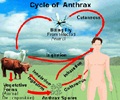Anthrax Vaccine Adsorbed Medication Information
Learn everything you need to know about Anthrax Vaccine Adsorbed-pronunciation, uses, dosage guidelines, indications, and when to take or avoid it.
Get up-to-date information on side effects, precautions, warnings, and proper storage to ensure safe usage.
Explore Anthrax Vaccine Adsorbed brand names commonly used in India and internationally, along with detailed pricing information. Consult your healthcare provider for tailored medical advice.
Generic Name : Anthrax Vaccine Adsorbed Pronunciation : AN-thrax VAX-een ICD Code : Y59.0 Therapeutic Classification : Immunizing AgentsBrand Names or Trade Names of Anthrax Vaccine Adsorbed
International :
Biothrax
Why is Anthrax Vaccine Adsorbed Prescribed? (Indications)
This medication is an active immunization agent for the prevention of disease caused by Bacillus anthracis, in persons between 18 and 65 years of age whose occupation or other activities place them at high risk of exposure.When should Anthrax Vaccine Adsorbed not be taken? (Contraindications)
Hypersensitivity.What is the dosage of Anthrax Vaccine Adsorbed?
Adults- 0.5 mL as 5 intramuscular doses at day 0, week 4, then 6, 12, and 18 months. Yearly booster injections of 0.5 mL are recommended for those who remain at risk.How should Anthrax Vaccine Adsorbed be taken?
It comes as a solution for injection, to be administered by a healthcare provider into the large muscle.What are the warnings and precautions for Anthrax Vaccine Adsorbed?
• Caution needed for elderly, children, pregnant and breastfeeding women. Select a different injection site for each sequential injection of this vaccine.• BioThrax may be administered by the subcutaneous route for the persons with coagulation disorders.
What are the side effects of Anthrax Vaccine Adsorbed?
Most Common - Injection site tenderness, pain, warmth, muscle pain, arm motion limitation, fatigue and headache.Central Nervous System - Tingling, tremor, nerve disease, dizziness, seizures, tremors, aseptic meningitis, encephalitis, transverse myelitis, cerebrovascular accident, facial palsy, hearing and visual disorders, Guillain-Barre Syndrome, and multiple sclerosis have been reported rarely; however, causality has not been established.
Skin - Itching, rash, hair loss, subcutaneous nodule, induration, and local pruritus.
Eye and ENT - Throat pain.
Gastrointestinal - Nausea, anorexia, diarrhea.
Hypersensitivity - Angioedema, rash, hives, itching, redness of the skin, and Stevens-Johnson syndrome.
Musculoskeletal - Back pain, neck pain, joint sprain, rigors, joint pain, damaged skeletal muscle.
Respiratory - Upper respiratory tract infection, transient respiratory difficulty.
Miscellaneous - Painful menstrual cycle, fever, chills, and influenza-like illness.





